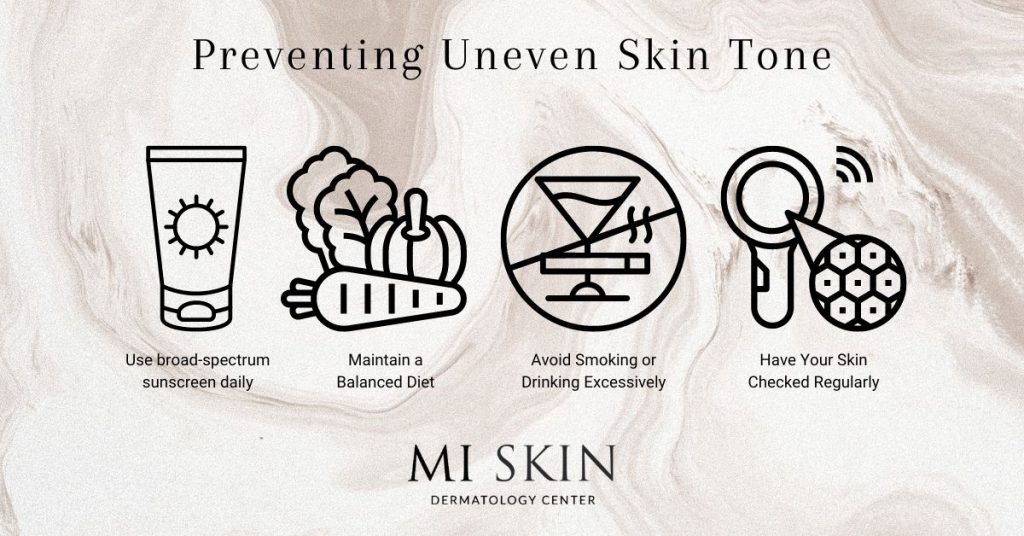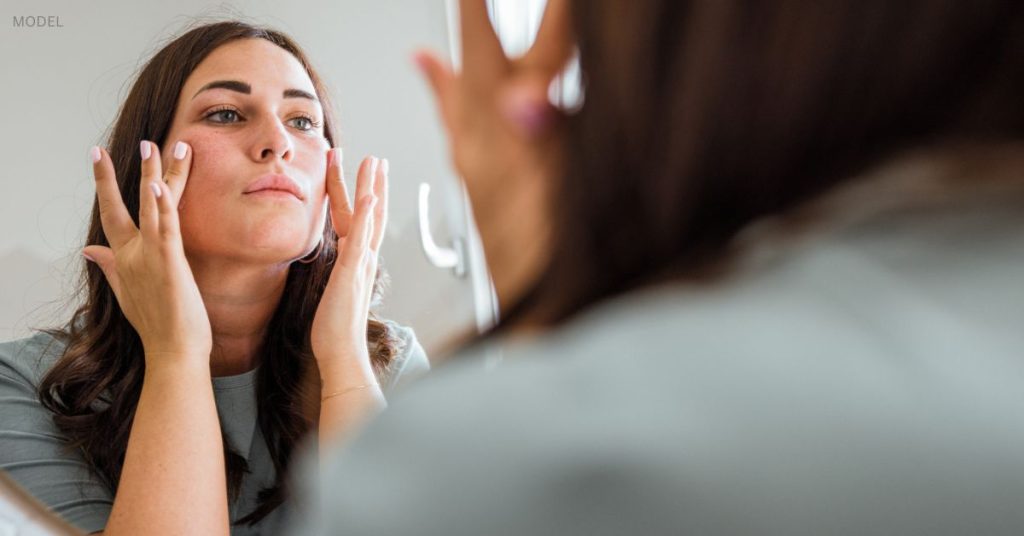A smooth and even skin tone is often considered a hallmark of healthy, radiant skin. But if you spend a lot of time in the sun, the damaging effects of ultraviolet (UV) light can contribute to an uneven complexion. This undermines both the appearance and health of your skin. Understanding what causes uneven skin tone on the face and taking proactive steps to prevent it can help you achieve and maintain vibrant, healthy skin.
What Causes Uneven Skin Tone?
Prolonged, unprotected exposure to the sun’s UV rays is the prime culprit responsible for uneven skin tone. Harmful UVA and UVB rays penetrate the skin, leading to the overproduction of melanin—the pigment responsible for skin color. This overproduction can result in dark spots, sun spots, and an uneven complexion.
Other factors can take a toll on your skin. Hormonal changes, such as during pregnancy, can trigger excess melanin production that results in a condition known as melasma. This causes dark, blotchy patches on the skin. Injuries, cuts, and acne also stimulate melanin production as the skin heals, leading to dark spots and patches. Additionally, aging affects the skin’s natural ability to shed dead cells. Combined with a slowdown in collagen production, this leads to a buildup of dull and discolored skin cells, which contributes to an uneven tone. Believe it or not, even screen time, i.e. sitting in front computer, can contribute to skin discoloration!
Sun Damage Is More Than a Cosmetic Concern
Sun damage is the most common cause of skin cancer due to the exposure of skin to ultraviolet (UV) radiation. Recognizing the warning signs of skin cancers and precancers is crucial for early detection and successful treatment.
Here are the warning signs of the 3 most common types of skin cancers—basal cell carcinoma, squamous cell carcinoma, and melanoma—and a pre-cancerous condition, actinic keratosis:
Basal Cell Carcinoma (BCC)
Basal cell carcinoma is the most common form of skin cancer. It typically appears on areas of the skin frequently exposed to the sun, such as the face, neck, and hands. Schedule an appointment with a dermatologist if you notice any of the following:
- Open sore that doesn’t heal
- Reddish, irritated patch that’s slightly elevated
- Shiny or translucent bump with tiny blood vessels on the surface
- Pinkish, elevated growth with a depressed center
- Scar-like area that’s flat, white, yellow, or waxy
Squamous Cell Carcinoma (SCC)
Squamous cell carcinoma also occurs in sun-exposed areas but can also develop in other body parts. Warning signs include the following:
- Rough, scaly patches that crust or bleed
- A raised growth with a central depression that may look like a wart.
- Open sores that don’t heal
Melanoma
Much less common than either basal or squamous cell carcinomas, melanoma is a more severe and potentially deadly form of skin cancer that can develop anywhere on the body, including areas not exposed to the sun. Warning signs include the “ABCDE” rule:
Asymmetry: One half of the mole or spot does not match the other half.
Border: The edges are irregular, blurred, or poorly defined.
Color: The color is not uniform and may include shades of brown, black, white, red, or blue.
Diameter: The spot is larger than 6 millimeters across (about the size of a pencil eraser).
Evolving: The mole changes in size, shape, or color, or there’s new itching, bleeding, or crusting.
Actinic Keratosis
Actinic keratosis (AK) is a pre-cancerous condition caused by prolonged sun exposure. Even though it is not cancer, it can potentially develop into squamous cell carcinoma if left untreated. The warning signs are similar to those of SCCs, including rough, scaly patches and itching or burning. You might also notice skin thickening.
How Can You Even Out Your Skin Tone?
Healthy skin is attractive skin. If you’re self-conscious about sun spots, discoloration, or rough skin, a range of nonsurgical options are available to restore a smooth, vibrant complexion. Some of the uneven skin tone treatments we offer include:
Photodynamic Therapy (PDT): PDT combines a photosensitizing agent with intense light to eliminate precancerous lesions and other photodamage. The light-based therapy also kills acne-causing bacteria, leading to clearer, brighter, and more even skin.
Fraxel® laser skin resurfacing: The groundbreaking Fraxel laser platform includes options based on how aggressively or gently you want to treat an uneven skin tone. Fraxel works by selectively targeting areas of the skin and creating microscopic injuries without damaging adjacent tissue. The laser triggers the skin’s natural healing process to reveal fresh, new skin.
Lase MD Ultra® (thullium 1927nm laser): delivering light energy more superficially than the Fraxel, the LaseMD Ultra is approved for the treatment of actinic keratosis, brightens the skin by gently removing the superficial layers of the epidermis, and allows for deeper penetration of tranexamic acid(TA). TA targets dark spots and melasma or mask-like discoloration.
PicoLO Premium picosecond laser: selectively destroys unwanted pigment without damaging healthy skin allowing for no downtime or recovery period. A series of treatment sessions is required spaced apart by 2-4 weeks in order to see results. Improved tone and pigment can be seen in all skin types.
Chemical peels: Besides minimizing sun and age spots and treating uneven pigmentation, chemical peels can also improve the appearance of fine lines and wrinkles. Chemical peels are selected based on the depth of penetration of the acid into the skin and the desired result. Chemical peels are classified into superficial (epidermal) peels such as glycolic, mandelic and salicylic acid peels for treatment of fine lines and pigment. Medium depth or trichloracetic acid (TCA) peels penetrate into the dermis and target pigment, photo damage, deeper wrinkles as well as pre cancers.
Microneedling: Similar to laser skin treatments, microneedling stimulates the skin’s repair process by creating tiny injuries. Microneedling or percutaneous collagen induction therapy can be performed with or without additional energy. The Genius RF microneedling device delivers radiofrequency energy through gold-tipped microneedles to the skin’s deeper layers to tighten skin, smooth lines and enhance results. All microneedling devices allow topical products to penetrate more deeply for added benefit, when used appropriately.
Can You Prevent Uneven Skin Tone?

When it comes to skin care for an uneven skin tone, the most important habit to develop—to protect the skin against future damage and maintain the results of your treatments—is applying a quality, broad-spectrum sunscreen every day. Broad-spectrum sunscreens protect the skin from both UVA and UVB rays. It should have a sun protection factor (SPF) of at least 30. Also, be sure to wear protective clothing, hats, and sunglasses outdoors.
Eating a balanced diet rich in antioxidants and staying hydrated supports skin health. Avoid smoking and excessive alcohol consumption, which can contribute to premature aging and skin damage. It also helps to incorporate gentle exfoliation into your skincare routine a couple of times a week. This helps remove dead skin cells and encourages cell turnover without over-exfoliating. Topical physician-grade vitamins and antioxidants are also helpful in maintaining bright and healthy skin.
Get Regular Skin Checks
Even if you don’t notice any skin cancer warning signs, scheduling regular skin checks with a dermatologist is essential to maintaining your skin’s health. Troublesome lesions or growths may occur in areas you can’t see. A dermatologist can provide personalized recommendations for your skin type and concerns. Regular visits allow them to monitor your skin’s health and suggest appropriate treatments or adjustments to your routine.
Request a Consultation
If you’d like to have a skin cancer screening with a board-certified dermatologist and learn how you can treat uneven skin tone or address other skin concerns, call our Washington, DC, office today at (202) 393-7546 or request a consultation.


Leave a Reply